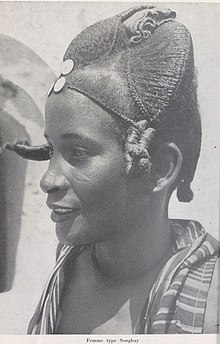 Songhay woman, Niger (1900s) | |
| [1][2] | |
| Languages | |
|---|---|
| Songhoyboro Ciine, Koyraboro Senni, Humburi Senni, Tondi Songway Kiini, Koyra Chiini | |
| Religion | |
| Islam | |
| Related ethnic groups | |
| Zarma, Tuareg |
| Person | Songhaiboro |
|---|---|
| People | Songhaiborai |
| Language | Songhai Sanni |
The Songhaiborai (also Songhai, Songhay, Sonrhaï) are a distinct subgroup within the larger Songhai ethnolinguistic family. Residing predominantly in Niger's Songhai region, Northern Mali, and a minority presence in Burkina Faso. Notably, they trace their lineage to the ruling dynasties of the ancient Songhai Empire.[3]
In Niger and Burkina Faso, differentiating the Songhaiborai from the Zarma people poses a challenge, as both are subgroups within the same language family, sharing a very similar dialect and culture. Despite the significant commonalities, the Songhaiborai may identify themselves and their dialect as "Zarma," emphasizing the shared heritage. However, both groups acknowledge their distinct branches within the same ethnicity, often adopting the collective name "Zarma," making it difficult for outsiders to discern any noticeable differences. Additionally, in Mali, they are recognized as the Koyraboro.[4]
The Songhai originally were the descendants and partisans of the Sonni dynasty that retreated to this area of present Niger after the coup d'état of 1493[5] and that of the Askia dynasty that also moved later to this same region after the invasion of the Songhai Empire by the Saadi dynasty of Morocco in 1591. These two historical events that resulted in the mass exodus of the Songhai emptied Gao and Timbuktu of their Songhai nobles, who find themselves dispersed today in the above-mentioned region of Southwestern Niger.[6][7][8][9]
- ^ "Africa: Niger - The World Factbook - Central Intelligence Agency". www.cia.gov. 27 April 2021. Retrieved 1 May 2021.
- ^ Niger, retrieved 2021-03-12
- ^ Zarma, a Songhai language, retrieved 2021-02-23
- ^ Stoller, Paul (1992), The Cinematic Griot: The Ethnography of Jean Rouch, University of Chicago Press, p. 59 "In this way the true Songhay, after the seventeenth century, is no longer the one of Timbuktu or Gao, but the one farther south near the Anzourou, the Gorouol, on the islands of the river surrounded by rapids" (Rouch 1953, 224), ISBN 9780226775487, retrieved 2021-06-04
- ^ Idrissa, Abdourahmane; Decalo, Samuel (2012), Historical Dictionary of Niger by Abdourahmane Idrissa, Samuel Decalo, Scarecrow Press, p. 414, ISBN 9780810870901, retrieved 2021-03-17
- ^ Olivier de Sardan, Jean-Pierre (2000), Unité et diversité de l'ensemble songhay-zarma-dendi
- ^ Bernussou, Jérôme (8 June 2020), "Chapitre I. Les nouveaux axes de l'historiographie universitaire : « histoire totale » et « histoire politique », à partir des années 70", HISTOIRE ET MÉMOIRE AU NIGER, Méridiennes, Presses universitaires du Midi, pp. 41–112, ISBN 9782810709519, retrieved 2021-03-30
- ^ Southern Songhay Speech Varieties In Niger:A Sociolinguistic Survey of the Zarma, Songhay, Kurtey, Wogo, and Dendi Peoples of Niger (PDF), Byron & Annette Harrison and Michael J. Rueck Summer Institute of Linguistics B.P. 10151, Niamey, Niger Republic, 1997, retrieved 2021-02-23
- ^ Soumalia, Hammadou; Hamidou, Moussa; Laya, Diouldé (January 1998), Traditions des Songhay de Tera (Niger) by Hammadou Soumalia, Moussa Hamidou, Diouldé Laya, KARTHALA Editions, ISBN 9782865378517, retrieved 2021-04-14